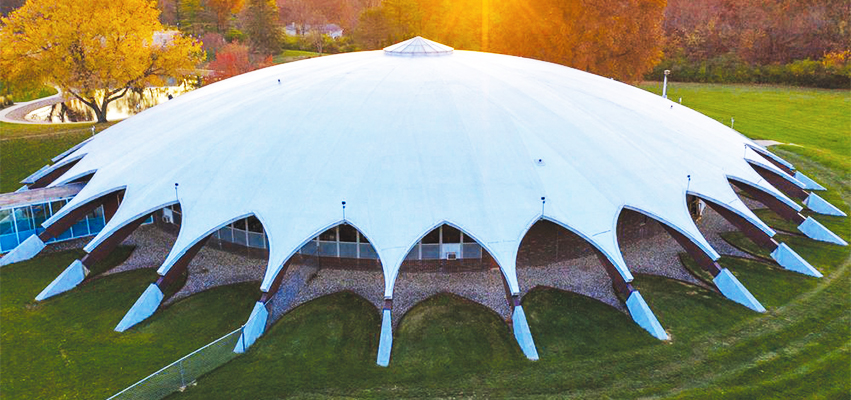We go by them every day, the treasures left to us by professionals of a bygone era.
Peoria has been home to many architects who left their professional mark on this city by creating public buildings still in use for governing, learning, entertainment and worship.
Often these architects ‘chose big and showy’
— Tim Hartneck
The local public building getting the most glory in recent years is Peoria City Hall. In 2017, it was chosen “best city hall” in the country via an online competition conducted by the group Engaging Local Government Leaders.
Coincidentally, it was through a competition that the original architects of the esteemed building were chosen.
The city had invited all local architects to submit plans for the new municipal building and seven firms responded, said Tim Hartneck, who has been studying local architectural history as an avocation for 50 years. He tells of the original design from William Reeves and John Baillie being more in the Italian Renaissance style, with a flat roof. The city went back to the duo, asking them to resubmit their renderings with a raised roof. The firm responded with ornamented gables and a cupola bell tower, giving it a Flemish Renaissance design. Reeves and Baillie got the job.
Made of red sandstone from Lake Superior, construction on what would become Peoria City Hall began in 1897 on a budget of $100,000. The building was dedicated Jan. 5, 1899, at a final cost of $235,000 – almost $8.4 million in today’s dollars.
“Looking at architectural periodicals from that time and what was popular, the building could have been anything, from Romanesque to Beaux Arts,” said Hartneck. “They chose big and showy.”
Besides Peoria City Hall, the Reeves and Baillie firm designed the McLean County Courthouse (now housing the McLean County Museum of History), Spalding Institute, the coliseums at the Illinois and Iowa state fairgrounds, St. Bernard’s Church, Douglas School (no longer standing) and the original Harrison School. In all, they designed at least 60 schools throughout central Illinois, said Hartneck, as well as a number of Peoria homes that are still standing.
Another structure of historic significance that periodically hits the news is the Madison Theatre. Designed by Peoria architect Frederick J. Klein, the building opened at Main Street and Madison Avenue in 1920 as a silent picture theater, with an Italian Renaissance exterior and classically beautiful plasterwork on the interior walls.
Over the years, it sat empty for long stretches, with more than one plan to rehabilitate the theater to its former glory. The Madison Preservation Association recently took ownership of the building with ambitions to do just that.
Like most architects of his time, Klein worked in all kinds of styles, said Hartneck. He designed many banks in small towns throughout central Illinois, as well as a lot of theaters. Besides the Madison, the self-taught Klein also envisioned Peoria’s Apollo Theater and the Coronado Theatre in Rockford.
“In 1982 or ’83, I was able to get into an office of Frederick Klein’s at Main and Jefferson, where Jay Janssen’s law office now stands,” said Hartneck. “Apparently, during the Depression, Klein had been unable to pay his office rent at one time and the landlord locked him out. The office had been abandoned for 50 years, since the 1930s. We were told to take whatever we could.”
Hartneck was able to salvage presentation drawings, periodicals, photographs and receipt books.
Some of Klein’s other local projects include Trinity Lutheran Church, Packard Plaza, Franklin School and Peoria High School, as well as residences.
Another popular local architectural firm from the same era was Hewitt and Emerson. “For a while they were the preeminent firm in town,” said Hartneck. “Like other architects, they did residential work, schools and banks.”
Their larger projects included the Peoria Life Building (which became Commerce Bank, now called 416 Main), Commercial National Bank (now PNC Bank), and the Interurban Railroad Terminal, which later become the Peoria Police headquarters. They were also the local consulting architects on the Pere Marquette Hotel.
Mid-Century Modern design is abundant in Peoria and two of the most notable local practitioners were Richard Doyle and Cletis Foley.
Doyle’s first vocation was music. As a teenager from Wheaton, he had his own band. In 1939 he enlisted in the service, where he was named an Air Force band leader. After World War II, Doyle studied architecture under the GI Bill. It is perhaps only fitting that Doyle’s own favorite design, the Kelly Avenue Library in Peoria Heights, has been turned into a performing arts center, the Betty Jayne Brimmer Center for the Performing Arts.
Doyle, in collaboration with local philanthropist Bill Rutherford, designed Tower Park in Peoria Heights. Doyle’s other local contributions include Peoria Heights Village Hall and that community’s Congregational Church.
Doyle was a man at one with his design principles. Modernism is seen as an optimistic, forward-thinking design movement. He practiced his optimism in his community, serving as architect for the Peoria Heights school district and then as its board president.
Doyle died in 2006.
Cletis Roy Foley was another Peoria architect who believed in the transformative power of Mid-Century Modern design. He also was a man ahead of his time, building Peoria’s first high-rise condominium building, which still stands at 4444 N. Knoxville Ave.
Among his most notable works is the Motherhouse near Germantown Hills, built in a pastoral setting of some 40 acres in the late 1960s as the novitiate for the Sisters of the Third Order of St. Francis. His other designs include the Demanes Interiors building on Knoxville, the Ameren/CILCO Headquarters on Liberty Street with its blue panels, downtown YMCA, now Dream Center; Central Park Pool and the former Varsity Theater.
After working with a couple of local architectural firms, Foley wanted to get “back into the trenches” of design and formed the firm Apace (Associated Professional Architects and Consulting Engineers) with two fellow modernist designers.
‘FOLEY WAS THE GRANDPA I NEVER HAD, AND A MENTOR TO MANY YOUNG ARCHITECTS’
— Architect, Mark Misselhorn
Architect Mark Misselhorn worked with Foley for 30 years and calls him “the grandpa I never had and a mentor to many young architects.
“He was a really great guy and a cool guy. Even into his 90s he was tooling around Peoria in his purple MG,” Misselhorn said.
Foley did hundreds of projects, said Misselhorn, including numerous churches, schools and residences, “but his pride and joy was the Motherhouse.”
A member of Westminster Presbyterian Church, Foley was a Sunday School teacher, elder, and also a local Boy Scout leader. He died in 2013 at the age of 100.
Photo credits: Reeves and Baillie – publication “Notable Men of the West”. Hewitt – Local History Collection at the Peoria Public Library





